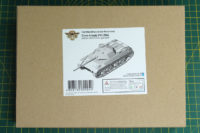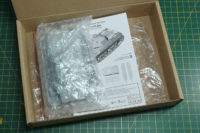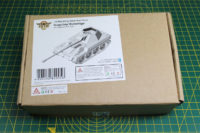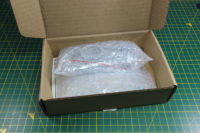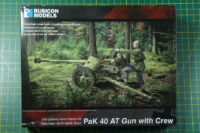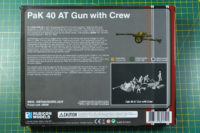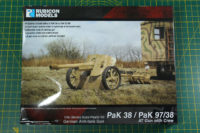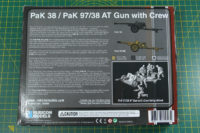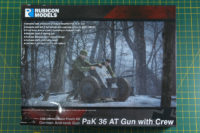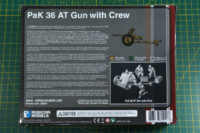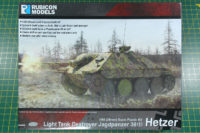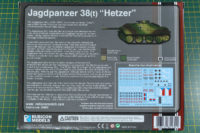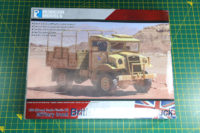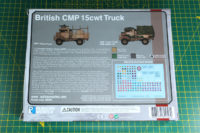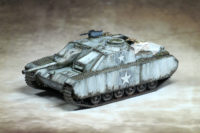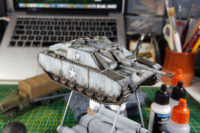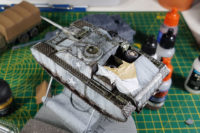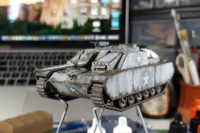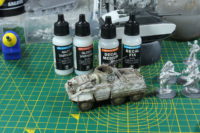Heer46 Carro Armato P43 Bis
Following the Krupp-Steyr Waffenträger from Tuesday, today we unpack and build the Armato P43 Bis by Heer46.
This is another tank from the resin series produced in cooperation with Rubicon Models. The Armato P43 was an Italian heavy tank that was developed by FIAT and Ansaldo, but never left the draft stage. The sources why the development stopped are not clear, some say the design was dropped in favour of the lighter P26/40 tank, but it is likely that the resources were just not available after the armistice of Italy with the Allies in 1943 and the Axis had other things valued higher than Italian tank development. Only two mock ups were build, but as mentioned before not further progressed. The tank was intended to weigh around 30 tons and have a 420-430 hp diesel V12 engine. The name Carro Armato P43 stands for armoured vehicle, P for pesante - Italian for heavy - and the number '43 most likely standing for the development year.
Heer46 Krupp-Steyr Waffenträger
There is a new range of 1:56 scale resin kits produced by Heer46 in cooperation with Rubicon Models, as an addition to Rubicon extensive plastic range. One of the vehicles offered as part of this assortment is the Krupp-Steyr Waffenträger.
Among the several Waffenträger (and their blueprint / papertank / prototypes) the Krupp Steyr Waffenträger is one of the less known vehicles. And like many of his kind, this tank destroyer never actually saw service. Only a similar concept of this Waffenträger, known as the Ardelt project was produced and can be seen nowadays in the Kubinka tank museum in Russia. Two wooden models and one trial Waffenträger were produced in 1944, that had a chassis constructed by Steyr mainly using parts from the RSO (Raupenschlepper Ost), and armed with an 8,8 cm KwK 43. This was the base for the model we see here. Due to the turret, and in combination with a small mobile ramp, the firing arch of this Waffenträger was amazing versatile. As this is a rather special vehicle, there aren't that many further information available. Most may know the Waffenträger from games likes Warthunder or World of Tanks.
Rubicon Models PaK 40 AT Gun with Crew
After a brief detour into the Wild West, we're back to anti-tank gun week with the PaK 40 by Rubicon Models.
The 7,5 cm Panzerabwehrkanone 40 or PaK 40 was the backbone of the late war German anti-tank guns. More than 23.000 units were produced and mostly used on carriages, but some were mounted to tank destroyers like the Marder series. Development of the PaK 40 started early, when the first Soviet tanks were brought to Berlin in 1939 and the 5 cm ammunition of the PaK 38 that was still tested at that point, proofed to be not powerful enough to deal with the newer designs of slopped and thicker armour.
Rubicon Models PaK 38 – PaK 97/38 AT Gun with Crew
Today we're looking at the successor of the PaK 36, the PaK 38 by Rubicon Models. This kit covers the variants 38 and 97/38 of the anti-tank gun including a crew.
Rheinmetall-Borsig, who produced the earlier PaK 36 as well, were ordered to develop a new, heavier anti-tank gun after the Spanish Civil War. After an initial sketch of a new pattern named 37, which was not approved by the German authorities, they had to come up with an improved version, the PaK 38. This more powerful anti-tank gun was one of the few guns being able to penetrate the sloped armour of the T-34 in 1941.
Rubicon Models PaK 36 AT Gun with Crew
This week is all about anti-tank guns. We'll cover a couple of different sets in 28mm, beginning with this PaK 36 AT Gun incl. crew by Rubicon Models.
The PaK (Panzerabwehrkanone) 36 was a German anti-tank gun, that was issued to the German army in 1936 and used by the tank hunter units until 1942. It even saw action before World War 2 in the Spanish Civil War, and performed well against the light tanks and later against the Polish tanks in 1939. In the Battle of France it showed its weakness against French and British heavy tanks. The PaK 36 was replaced from late 1940 onward by the 5 cm PaK 38 anti-tank gun and from November 1941 by the 7.5 cm PaK 40. Until the production ceased completely, there were over 20.000 units produced, of which roughly 6.000 were built for export. Other nations like the Soviet Union and Japan copied the design in the 1930s.
Rubicon Models Jagdpanzer 38(t) Hetzer
You can't talk about the 38(t) series without mentioning the Jagdpanzer 38(t) Hetzer, and that is why today I cover the kit by Rubicon Models in this review.
As the tank destroyers Marder based upon the Panzer 38(t) were more of an industrialized "field conversion" using captured anti-tank guns and later regular PaKs, a properly designed light tank destroyer was needed. Introduced as the Sd.Kfz. 138/2 Jagdpanzer 38(t), this tank was produced from April 1944 until the end of the war, along the heavier Jagdpanther and Jagdtiger variants. The name "Hetzer" is undocumented and it is unclear, were it actually came from and it is highly discussed if the tank even was called that during the war. Hetzer comes from the German verb "hetzen", meaning hounding or rushing somebody or something.
Rubicon Models British CMP 15cwt Truck
In addition to the Northern Africa campaign week in November, I want to cover the British CMP 15cwt Truck by Rubicon Models in a review today.
The CMP stands for canadian military pattern. This truck was build in Canada and used by armies of the British Commonwealth and even sent to the Soviet Union after Operation Barbarossa. Due to this, it saw action on theatres of war all over the world, from the North African Campaign, Italy, Burma and even after the second World War in Indonesia, Indochina and portuguese colonies in Africa. In Australian service (almost always with the No. 13 cab as supplied with this kit), the CMP was known as "Chev Blitz" or "Ford Blitz".
Ersatz StuG Ausf. G and more Germans in winter gear
The StuG is done and here are the proper picture of the third vehicle for my Unternehmen Greif / Panzerbrigade 150 force for Bolt Action.
You can read about the work in progress in more detail over here, Ersatz Stug Ausf. G WIP. I thought a double sided Zeltbahn camouflage would be a nice detail for the vehicle. Went with winter / snow camouflage in "pure" white on the one side and a splitter tarn on the other side. There were reversible smocks for the infantry, proper details on the zeltbahn or vehicle netting are more difficult, so take this with some historical "liberty".
Ersatz StuG III Ausf. G Work-in-Progress
Almost there with the Ersatz StuG Ausf. G for the 150th Panzerbrigade / Unternehmen Greif. Finished the white wash camo, decals are done, weathering with mud and cracks is satisfying. Only part missing so far is the stowage. Have to take care of the spare wheel, the jerrycans and the Zeltbahn. Actually, I'm thinking about doing a splinter-pattern on the one side and leave the other one white, as snow camo.
When I started converting the Ersatz StuG I had a few black and white pictures of the Battle of the Bulge aftermath, and some more pictures of the Flames of War 15mm variant and a conversion tutorial by Warlord Games. In addition I found this one by Roy Chow on Network 54. I covered my own conversion in here (Unternehmen Greif) and here (Captured Ford M8a).
Ford M8(a) captured vehicle and further winter gear
On the weekend I managed to do the last touches on the captured M8 Greyhound, named Ford M8(a) by the Germans. Applying the last few weathering bits and the fitting decals onto the vehicle.
I used the Decal Fix and Medium by Vallejo, quite easy to use and the results speak for themself. Some suggest that you prepare the area with gloss varnish, I just used the Decal Medium, placed the decal and added a few thin coats of Decal Fix to soften the edges. Later "protect" the decal with matt varnish (and it dulls the decal a bit and makes it blend better with it surroundings).
